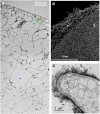Understanding the sexual recruitment of one of the oldest and largest organisms on Earth, the seagrass Posidonia oceanica
- PMID: 30444902
- PMCID: PMC6239318
- DOI: 10.1371/journal.pone.0207345
Understanding the sexual recruitment of one of the oldest and largest organisms on Earth, the seagrass Posidonia oceanica
Abstract
The seagrass Posidonia oceanica is considered one of the oldest and largest living organisms on Earth. Notwithstanding, given the difficulty of monitoring its fruits and seeds in the field, the development of P. oceanica during its sexual recruitment is not completely understood. We studied the stages of development of P. oceanica seeds from their dispersion in the fruit interior to their settlement in sediment through histological, ultrastructural and mesocosm experiments. P. oceanica sexual recruitment can be divided into three main stages that focus on maximising photosynthesis and anchoring the seedlings to the sediment. In the first stage (fruit dispersion), seeds perform photosynthesis while being transported inside the fruit along the sea surface. In the second stage (seed adhesion), seeds develop adhesive microscopic hairs that cover the primary and secondary roots and favour seed adhesion to the substrate. In the last stage (seedling anchorage), roots attach the seedlings to the substrate by orienting them towards the direction of light to maximise photosynthesis. The adaptations observed in P. oceanica are similar to those in other seagrasses with non-dormant seeds and fruits with membranous pericarps, such as Thalassia sp. and Enhalus sp. These common strategies suggest a convergent evolution in such seagrasses in terms of sexual recruitment. Understanding the sexual recruitment of habitat-forming species such as seagrasses is necessary to adequately manage the ecosystems that they inhabit.
Conflict of interest statement
The authors have declared that no competing interests exist.
Figures





Similar articles
-
Evidences of adaptive traits to rocky substrates undermine paradigm of habitat preference of the Mediterranean seagrass Posidonia oceanica.Sci Rep. 2015 Mar 5;5:8804. doi: 10.1038/srep08804. Sci Rep. 2015. PMID: 25740176 Free PMC article.
-
Biological adhesion in seagrasses: The role of substrate roughness in Posidonia oceanica (L.) Delile seedling anchorage via adhesive root hairs.Mar Environ Res. 2020 Sep;160:105012. doi: 10.1016/j.marenvres.2020.105012. Epub 2020 May 12. Mar Environ Res. 2020. PMID: 32907731
-
The perfect microsite: How to maximize Posidonia oceanica seedling settlement success for restoration purposes using ecological knowledge.Mar Environ Res. 2020 Oct;161:104846. doi: 10.1016/j.marenvres.2019.104846. Epub 2019 Nov 23. Mar Environ Res. 2020. PMID: 32823174
-
Effects of disturbances caused by coastal constructions on spatial structure, growth dynamics and photosynthesis of the seagrass Posidonia oceanica.Mar Pollut Bull. 2003 Dec;46(12):1523-33. doi: 10.1016/j.marpolbul.2003.08.021. Mar Pollut Bull. 2003. PMID: 14643778 Review.
-
Advances in understanding multilevel responses of seagrasses to hypersalinity.Mar Environ Res. 2023 Jan;183:105809. doi: 10.1016/j.marenvres.2022.105809. Epub 2022 Nov 16. Mar Environ Res. 2023. PMID: 36435174 Review.
Cited by
-
Antioxidant and Anti-Inflammatory Properties of Four Native Mediterranean Seagrasses: A Review of Bioactive Potential and Ecological Context.Mar Drugs. 2025 May 12;23(5):206. doi: 10.3390/md23050206. Mar Drugs. 2025. PMID: 40422796 Free PMC article. Review.
-
A novel adaptation facilitates seed establishment under marine turbulent flows.Sci Rep. 2019 Dec 23;9(1):19693. doi: 10.1038/s41598-019-56202-7. Sci Rep. 2019. PMID: 31873181 Free PMC article.
-
Tannins and copper sulphate as antimicrobial agents to prevent contamination of Posidonia oceanica seedling culture for restoration purposes.Front Plant Sci. 2024 Nov 25;15:1433358. doi: 10.3389/fpls.2024.1433358. eCollection 2024. Front Plant Sci. 2024. PMID: 39654965 Free PMC article.
References
-
- Les DH, Cleland MA, Waycott M. Phylogenetic studies in Alismatidae, II: evolution of marine angiosperms (seagrasses) and Hydrophily. Syst Bot. 1997;22: 443–463. 10.2307/2419820 - DOI
-
- Hughes AR, Williams SL, Duarte CM, Heck KL, Waycott M. Associations of concern: declining seagrasses and threatened dependent species. Front Ecol Environ. 2009;7: 242–246. 10.1890/080041 - DOI
-
- Heck KL, Hays G, Orth RJ. Critical evaluation of the nursery role hypothesis for seagrass meadows. Mar Ecol Prog Ser. 2003;253: 123–136. 10.3354/meps253123 - DOI
-
- Collier CJ, Waycott M. Temperature extremes reduce seagrass growth and induce mortality. Mar Pollut Bull. 2014;83: 483–490. 10.1016/j.marpolbul.2014.03.050 - DOI - PubMed
-
- Waycott M, Duarte CM, Carruthers TJB, Orth RJ, Dennison WC, Olyarnik S, et al. Accelerating loss of seagrasses across the globe threatens coastal ecosystems. Proc Natl Acad Sci U S A. 2009;106: 12377–81. 10.1073/pnas.0905620106 - DOI - PMC - PubMed
MeSH terms
LinkOut - more resources
Full Text Sources

